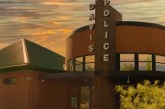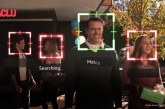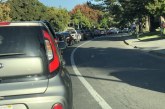 The December death of Megan Glanville, a Davis resident originally from Chico, has pushed the city to take further steps to protect pedestrians and others at the intersection of Russell Blvd and Lake Blvd on the westernmost outskirts of Davis.
The December death of Megan Glanville, a Davis resident originally from Chico, has pushed the city to take further steps to protect pedestrians and others at the intersection of Russell Blvd and Lake Blvd on the westernmost outskirts of Davis.
Staff has come forward with a consent item, based on council’s direction to staff to evaluate Russell Boulevard west of SR-113 and other high-speed rural roads entering the City, for possible traffic safety improvements.
Based on staff’s review of the intersection of Russell and Lake, they suggest three short-term improvements “to help improve visibility and slow Russell Boulevard traffic at the Lake Boulevard intersection.”
First, they want to improve the intersection to an all-way stop, as opposed to the current condition where Lake Blvd drivers stop but not Russell Blvd drivers. Staff argues, “Stop warrants are narrowly met, based on a recent vehicle count done in late 2011.” They add, “This is a ‘tee’ intersection with Lake Boulevard stopping at Russell Boulevard. There is also a bike path connection across from Lake Boulevard that stops on Russell Boulevard (the fourth leg of the intersection).”
Second, they plan to install a flashing beacon at the intersection which would flash red in all directions to alert drivers of the all-way stop intersection.
Finally, they would add street lights at each quadrant to improve the lighting at the intersection, for a total of four additional street lights.
Reports staff, “Staff is preparing preliminary plans and a cost estimate for these proposed improvements. This short term improvement will be presented to the Safety and Parking Advisory Commission prior to returning to Council for consideration.”
“Following the Corridor Study, should any of the improvements noted above be inconsistent with the long term improvements, the materials can readily be removed and stored for use elsewhere in the City,” they add.
This area has been a problem for some time, however, last October, the county staff announced the need to raise speed limits west of Lake Blvd due to the unenforceability of current speed laws.
The County Board of Supervisors, after hearing safety concerns from residents along the corridor between Lake Blvd and Pedrick Road, declined to do so, but staff argued that current speed laws were not enforceable.
At that time, Supervisor Don Saylor recommended for the four roads studied that there be additional study for the next year, to include consideration of traffic-calming measures and to look toward a state law change.
One of our suggestions at the time was posting the speed limit – which is currently not visible for drivers moving from northbound Pedrick to eastbound Russell, and adding stop signs.
Then in late December a fatal accident occurred at the intersection of Russell and Lake. Officers determined that 61-year-old George Souza (a Woodland resident) was driving his Ford Pickup eastbound on Russell Boulevard.
25-year-old Megan Glanville (from Chico, but currently living in Davis) was crossing Russell Boulevard as a pedestrian where Russell intersects Lake Boulevard. As Megan Glanville crossed Russell, she was hit by the pickup truck driven by Mr. Souza.
Megan Glanville suffered severe injuries, including head trauma. She was rushed, by ambulance, to the UCD Medical Center in Sacramento. She would later die from these injuries.
At the time, police said that they did not believe that drugs or alcohol were a factor in this incident, but they suspected that the heavy morning fog played a role.
The problem with the entire stretch of road on Russell, that begins as soon as Arlington Blvd veers off from it, is that it looks like a rural road for a stretch of perhaps a mile to a mile and a half. But it is not a rural road.
The press release did not list the speed, but this is the exact problem that was brought up at the meeting with the Board of Supervisors back in October.
The county was concerned about the enforceability of the speed limit, and that was their impetus for wanting to raise the speed limit on this stretch.
Staff argued, “These actions will bring affected speed limits into compliance with the California Vehicle Code (CVC) and California Manual on Uniform Traffic Control Devices (MUTCD) and ensure that the posted speed limits are enforceable under state law.”
The California Vehicle Code (CVC) and the California Manual on Uniform Traffic Control Devices (MUTCD) govern the criteria for establishment of speed limits. The CVC sets the basic speed limit for two-lane, undivided highways at 55 mph.
According to the staff report, “Setting speed limits outside the guidelines constitutes a speed trap, under the CVC, and those speed limits are not enforceable using radar.”
That is based on the premise that they are required to set speed limits in the 85th percentile, that is, a speed at which 85% of the drivers will drive at a reasonable speed for the road and conditions.
“To establish a speed zone less than 55 mph the agency must conduct an E&TS [Engineering and Traffic Survey], including a speed zone survey,” the staff report argued.
According to Panos Kokkas, the Yolo County Assistant Director of Planning and Public Works, they did a speed survey last year that showed the 85th percentile for Russell Blvd was 49 mph, which he characterized as “rather high compared to the posted speed.”
Based on that, he argued that the speed limit would need to be 50 mph, but due to the residential areas, school, children and churches in the vicinity, they determined that they could lower that to 45 mph.
According to Mr. Kokkas, if the speed limit is not raised, it would go back to 55 mph, which is the basic non-posted speed limit, and people driving 55 mph or less could not be cited.
Concerns were raised that raising the speed limit would further drive up the speeds. But Mr. Kokkas, citing limited data from a pilot study conducted in Davis, argued that they should find that the actual speeds remained constant, despite the increase in the posted speed limit.
The motion made by Boardmember Don Saylor and passed by the Board of Supervisors instructed their staff to look into road-calming measures.
Supervisor Matt Rexroad, while concerned about raising speed limits, was concerned with the overall cost of such measures.
Now the city has at least gotten involved on their side of the city limit, but more must be done between Lake and Pedrick to protect public safety and the safety of children, who utilize church facilities and are being transported to and from school.
—David M. Greenwald reporting






[quote]First, they want to improve the intersection to an all-way stop, as opposed to the current condition where Lake Blvd drivers stop but not Russell Blvd drivers.[/quote]
It’s about time. I brought this issue to the city’s attention years ago, but was summarily ignored – even tho there were approximately 5 accidents at that site in a 12 month period. It is a shame it took the death of a pedestrian to get the necessary change implemented. However, I do think the city is much better at getting a handle on traffic safety than it was years ago…
I am greatly heartened to see this recommendation and hope the city implements it as soon as possible. The tragic death of Megan Glanville pointed out how dangerous this intersection can be. We would like to also recommend speed bumps or rows of ceramic pavement markers or signs to warn drivers approaching the intersection that they will need to stop. But this is a great step forward to remedy this dangerous situation.
An all-way stop at Russell/Lake is probably warranted, although it likely would not have saved Megan Glanville. From what has been reported, it appears that that she was struck by a vehicle that was traveling too fast for conditions (thick fog).
There are several hazards at the Lake/Russell intersection, which including:
Pedestrians and bikes entering the roadway from the bike path on both sides of the intersection. Many of the bikes are unlighted after dark, and some enter the roadway without stopping or watching for traffic.
A high percentage of westbound Russell traffic approaching Lake Boulevard fails to signal before turning right onto Lake. Interspersed with the right-turning traffic is a few westbound drivers, who often accelerate once the vehicle ahead turns onto Lake. A driver waiting to turn from Lake onto Russell is often frustrated by half-dozen or more right-turning vehicles that fail to signal, but takes a potentially fatal risk if s/he [i]assumes[/i] that a car will turn.
As discussed at length previously, eastbound traffic approaching Lake is often traveling at high speed. Lake Boulevard is the first Davis intersection that an eastbound driver encounters on Russell after driving on rural roads. Lake comes up fast for a driver who is unfamiliar with the area or impatient.
One suggestion I hope the City will consider would be to build a dedicated right turn lane onto Lake for westbound Russell traffic, with an island separating it from the through lane. The island would have a grade-level cut through it for bikes and wheelchairs. This would allow right-turning traffic to proceed without affecting the flow of other traffic in the intersection, and would force right-turning drivers to declare their intention (if not by signalling) by the act of moving into the right turn lane. The island would also provide a safe refuge for pedestrians and bikes crossing the street. If it is feasible, this improvement would improve safety and traffic flow, with or without a stop sign or signal.
My post above would have been easier to read if my HTML tags (ul and li tags) had been interpreted as they were in the preview.
[quote]An all-way stop at Russell/Lake is probably warranted, although it likely would not have saved Megan Glanville. From what has been reported, it appears that that she was struck by a vehicle that was traveling too fast for conditions (thick fog). [/quote]
I’m not following you here. If there had been a 3 way stop, if would force traffic to slow down through that intersection, thereby making it more likely this truck would have seen Megan in time. As it is now, there is no stop sign for east/west bound traffic on Russell at the intersection of Lake. Cars zoom through there at anywhere from 50 to 60 mph, regardless of weather conditions. With a 3 way stop sign, they will not be able to do that anymore (legally anyway). IMHO, a 3-way stop is precisely what is needed at that intersection, and has been needed for a long, long time…
Has anyone seen the accident investigation results? What if both parties were “going too fast” for the circumstances…. I’ve seen a lot of pedestrian, and to a similar extent, bicyclist behavior where if there had been a crash, I wouldn’t call it a traffic engineering failure, nor necessarily due to the driver of the motor vehicle. I’m sure we’ll never know the full cause(s) of the tragic crash, but pedestrians, in foggy conditions, need to be particularly vigilant prior to running (thought they reported jogging)across a two lane roadway at the edge of town. Stop, look and listen applied to ALL mode choices.
HRM, unfortunately the city could not install additional stop signs there because the amount of traffic did not warrant it. The latest count done in 2011 was the first time the amount of traffic surpassed the “threshold”, and just barely at that. The same thing goes for 2nd and B. It needs it, but the amount of traffic is to low to warrant. I do like Mr Suder’s idea of a dedicated turn lane.
As far as the accident is concerned, tragically Ms. Glanville crossed one lane safely, only to step in front of the truck. I believe that both parties had some fault in this.
[quote]I’m not following you here. If there had been a 3 way stop, if would force traffic to slow down through that intersection, thereby making it more likely this truck would have seen Megan in time.[/quote]
The fog was reportedly very dense when the accident occurred. I’m assuming that if the driver was going too fast to see Megan Glanville in time, he would have also been going too fast to see a stop sign in time to stop for it. We’ve also read that Ms. Glanville may have been struck somewhere west of the intersection – before the eastbound driver came to Lake Boulevard.
If there had been a stop sign at Lake and the driver was familiar with it, he may have been more cautious. (“There’s a stop sign right about here. Better slow down.”) However, he might have been focused on looking for the stop sign on his right, while Ms. Glanville was apparently crossing from the driver’s left. We’ll never know.
[quote]HRM, unfortunately the city could not install additional stop signs there because the amount of traffic did not warrant it. The latest count done in 2011 was the first time the amount of traffic surpassed the “threshold”, and just barely at that. [/quote]
Now this is interesting. So you are telling me that a stop sign cannot be installed at an intersection unless and until there is sufficient traffic to support it? Even if it is needed? If that is the law (or is it a local ordinance?), sounds like it needs to be changed…
At the risk of creating howls of protest, I would recommend that the City allow West Village to access Russell Blvd and develop Russell into more of a city street, rather than the county road that it is trying to remain. More cars = slower speeds, more intersections = more opportunities to slow traffic without surprises for drivers bombing down Russell. Drivers who want to drive fast to Hwy 113 will adjust, move south and use the Hutchinson on ramp instead of Russell. That goes for people headed for the University too. Hutchinson will be a more direct route to parking, etc. on campus.
[quote]At the risk of creating howls of protest, I would recommend that the City allow West Village to access Russell Blvd and develop Russell into more of a city street,rather than the county road that it is trying to remain.[/quote]
You’re kidding, right?
Not at all. With the build out of West Village, there will be more bike/pedestrian crossings of Russell to get to shopping, schools, etc. With intersections, there will be street lights and signaled crossings. Now there is little to slow down the cars. Change Russell to a city street and the traffic is forced to slow or stop completely while bikes and pedestrians cross. Adding a stop sign, just doesn’t cut it for me.
ERM: “Now this is interesting. So you are telling me that a stop sign cannot be installed at an intersection unless and until there is sufficient traffic to support it? Even if it is needed? If that is the law (or is it a local ordinance?), sounds like it needs to be changed…”
Elaine. No, that isn’t exactly correct. But some engineers, even here in DAvis, will tell you it is indeed “illegal” for them to install any traffic device that doesn’t meet their warrants. They will offer up the liability excuse for refusing to do that. These warrants are derived out of various manuals that are primarily guidelines, and carry no statutory authority. Moreover, there is no liability for the City or the individual engineer if the decision to install some traffic control feature is done 1. In the interest of safety, 2. With good intent, 3. Using the best judgement of the engineers involved. I would argue all three of those are met in the case of the Lake/Russell intersection.
A case in point: Senior management in the Public Works Department and representatives of Davis Bicycles! were told a year ago by a City empolyee engineer that the Manual of Uniform Traffic Control Devices REQUIRED them to install 8-footwide parking spaces (not 7-foot), even though the evidence supplied was a page from the MUTCD clearly marked “Example.” The actual single “requirement” (remember, it is only a guideline) is…. drum roll please.
The paint has to be white.
Steve Tracy